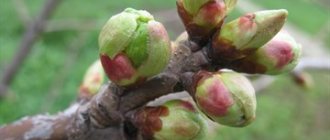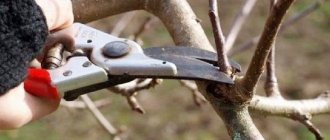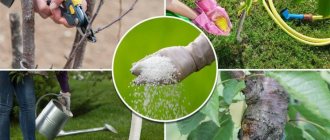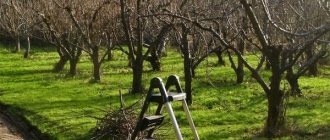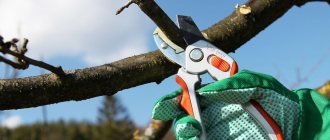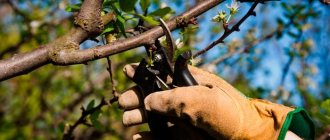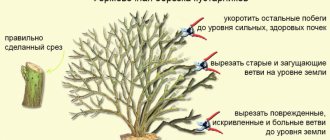Pruning old apple trees, as well as young ones, should be done in a certain way. In some ways, pruning apple trees is similar to raising children.
If you discipline apple trees by pruning too strictly, they become frail and sickly, uninitiative suffocates. Give them no restrictions, and they become unruly and unproductively growing “thickets.”
But if you give them the right pruning and feeding at the same time, they will form an attractive, useful tree form that will “produce” beautiful fruit for many years. Decrepit and damaged branches are dangerous to leave on a tree that has crossed the threshold of its old age.
If they are not cut off, the consequences for the tree will be unfavorable : diseases and harmful insects from damaged branches will begin to migrate to the still flowering branches, and due to the overly dense crown, the flow of sunlight to the tree will be reduced.
And as a consequence, the lack of timely pruning of apple trees leads to their death as a useful tree. Due to the extremely intensive growth of the crown, the tree produces tiny and unappetizing apples.
How to prune an old apple tree?
An apple tree will continue to produce fruit even when it is not looked after or becomes old. But the “effectiveness” of the harvest and its volume will fall with each season, and in some years there will be no apples at all.
Old age is also noticeable in the growth of underyearlings. If the growth of branches becomes very weak and small, the tree ages. And only by cutting off the excess can stray apple trees be “restored” and fruit bearing resumed .
More often, for such “restoration” the transfer method is used, that is, all skeletal branches are cut to the point where the strongest and youngest shoot is located, usually three years old. At the same time, they do not forget about subordination, where each subsequent upward tier of branches is cut off more than the previous one.
Remember! Do not prune while the ovary is forming!
If even after this the growth rate of young shoots has not been revived, then pruning of the “aged” apple tree is continued by even greater removal of the oldest branches.
Replacing the crown in two stages
A very common problem with trees in small areas is dense planting of tall varieties. The crown cannot be kept at an acceptable height, it thickens, the lower branches die off from lack of light. In 20-30 years, an apple tree grows ten meters or more in height. It is almost impossible to process and trim. You can’t get the harvest without a huge stepladder, and such a tree provides too much shade.
Not every tree is suitable for such a serious operation as a complete crown replacement. It is important that the trunk is practically healthy. A small hollow can be cleaned and filled with ordinary cement-sand mortar. It is usually recommended to replace the crown in two stages. In the first year, in the southern half of the crown, part of the skeletal branches is removed, and the remaining ones are greatly shortened and transferred to shoots growing in the direction desired by the gardener. For three years, the southern half of the crown is formed, and in the fourth, the same operation is repeated with the northern half. The advantage of this method is the possibility of obtaining an annual harvest.
The main and main thing in the system of pruning an adult apple tree
Gardeners in Europe have developed a system for pruning old apple trees, developed from rejuvenating pruning of neglected trees. It's called the update system. This method, which may at first glance seem difficult to implement for an amateur, is in fact a successful way to control the growth and age of fruit wood and the formation of fruit in the most favorable place for them.
In this system, only individual characteristics of the tree are taken into account and there are no hard and fast rules. And the system itself consists of reducing the share of excess annual growth. So that only the necessary part of the branches is left, and on the remaining part it will be possible to form fruit twigs.
Twigs and fruits should be well spaced along the entire length of the branch to ensure that the fruits are not crowded. The number of stepsons is reduced, but their total number will depend on the variety and growth of the apple tree.
A strong tree can “feed” a large number of apples. As a result, most of the stepsons that appear after anti-aging pruning should be shortened by 1/3, and their smaller half should be cut out.
On a weaker tree, which tends to form fruit buds due to the shoots of underyearlings, only the top of 2 out of 3 stepsons may be cut off. And the next summer, from these stepsons, they select those that best fit the definition of “real branches” and form a new fruiting link.
An ideal fruit tree should have only one central leading branch. You cannot allow two leaders, otherwise the tree will become weak. It is necessary to identify the only strong and strong leader among competitors and tops and remove all the others.
And this central leader should be surrounded by strong branches and evenly distributed fruit-bearing branches on them. Which have many twigs and fruits for fruiting.
Advice! Avoid pruning your apple tree in early September because it encourages the growth of new branches while the trees should be preparing for the winter season.
Signs of aging
With proper care, the lifespan of an apple tree is more than 300 years. But for most gardeners, fruit trees die by the age of 50-60. The reason usually lies in improper care of old plantings. The first signs of aging appear in apple trees by the age of 30. Their skeletal branches are exposed due to the loss of fruiting shoots. They die off from the center of the crown to the edges. As a result, apple tree productivity drops significantly.
Another sign of aging is slight growth. The tree increases in height minimally or stops growing completely. The top of the old apple tree dries out completely. There is a massive death of fruit and leaf shoots. Fruiting continues even during this period. But the apples grow small and their taste deteriorates.
Many branches form on the skeletal branches. Because of them, the load on annual growth increases. They produce nutrients, which are then distributed throughout the branch. Due to heavy load, annual growths are shortened and fruit branches dry out. Lichens and parasitic fungi develop on them. Such a tree is often abandoned or simply uprooted.
On a note! The fruits on an old apple tree are located only on the top or side. This makes it difficult to treat the crown and harvest.
Two main rules for pruning an old apple tree
The first rule of pruning is to remove all dead, damaged or diseased branches.
Second: cutting to a ring . When planning to make a cut, pay attention to the “branch collar” (or “ring”), which consists of the “wrinkled” part of the bark at the base of the branch where its end is connected to the tree trunk. This part of the tree has all the cells necessary for wound healing.
Important ! Never cut the collar of a branch when pruning! Instead, you need to make a cut just above it.
Removing old crown in one step
However, often in old trees it is at the first forks that there is diseased, damaged, hollow wood. In this case, you can try the most drastic method - removing the crown in one step. The crown is sawed off at a height of 60-150 cm. The height is chosen according to the condition of the bark. The rougher the bark, the less likely it is that the so-called “dormant buds” will wake up. It’s good if there are already at least small shoots at a suitable height, you won’t have to worry about the buds sleeping too deeply. In this case, the cut should be placed 2-3 cm higher. Photo 2 shows how, in two years, powerful roots turned two weak shoots and two dormant buds into two-meter branches overgrown with shoots.
Photo 2
Of course, they should have been pruned and directed to grow where they needed to be in the first year, but the gardener didn’t get around to it. The situation is completely fixable. A few simple manipulations.
- We trim off most of the shoots “to taste.” Photo 3.
Photo 3
- We hammer four stakes around the tree from available materials (rebar, rod, wooden stakes).
- Smoothly and gradually (possibly over several days) we deflect the branches to the desired angle, pulling them to the stakes with twine. It is imperative (!) to use a spacer between the twine and the bark. For example, a piece of felt insole, as in photo 4.
Photo 4
The result shown in photo 5 is not pleasing to the eye. Instead of replacing the crown, there are some sticks sticking out. But this is a misleading impression. The pruning was done on January 27th. In the spring, these rejected branches became covered with leaves and bloomed profusely, and in the fall they produced a dozen apples.
Photo 5
In another two years, the old trunk will be crowned with a new full-fledged crown, shaped like a bowl.
Apple tree with new crown
If you have an old tall tree of a good variety on your site, do not rush to remove it, experiment, give free rein to your imagination and hands. You may end up with a strong tree of the shape you want. And it’s never too late to uproot!
PS Using the above methods you can rejuvenate not only apple trees, but also cherries, walnuts, plums, pears, and peaches. The main condition is healthy roots and trunk.
Andrey Udalov, amateur gardener (Krasnodar region), photographs by the author.
© 2013 - 2014, Planting a Garden. All rights reserved.
sazhaemsad.ru
Pruning old apple trees in autumn: diagram
If you don't yet know how to properly prune an old apple tree in the fall, the diagram below will help you. To carry out effective pruning, you need to adhere to a program consisting of a certain sequence of actions:
- Cut out the oldest branches , those that for various reasons have become broken or damaged;
- Further, where a large number of small branches grow, the crown should be thinned out, preserving the strongest and smoothest; painful and twisted branches need to be cut out;
- Then those branches that leave the trunk at a small angle are cut off ; after all, with abundant fruiting, such branches can break under the load of ripened apples;
- Remove all rubbing and tangled branches and remove all stumps “on the ring”;
- After this, all sections of the branches must be carefully cleaned of burrs and irregularities, otherwise morning frosts can injure the phloem. Next, apply “garden pitch” to treat wounds; it is also possible to seal wounds with oil paint or natural drying oil;
- At the end of the work, all the branches that were cut must be put in one place and burned to ashes; this is necessary to destroy possible insect pests and rot that could appear on weak and stunted branches.
Remember that pruning an old apple tree in the fall is the key to a good harvest next year. Also, do not forget that if a large number of apples are ripening, the branches should be protected from breakage due to the severity of the harvest with the help of supports.
Basic rules for anti-aging pruning of fruit trees
Professional pruning requires deep knowledge of tree biology and practical skills, but an amateur gardener only needs to follow a few basic rules:
- Be sure to cut out all diseased branches.
- Remove branches that grow almost vertically.
- Cut out the branches growing inside the crown.
- Find pairs of branches rubbing against each other and remove one of them.
- If two skeletal branches grow directly above each other at a distance of less than half a meter, then leave one of them.
After these points are completed, thinning is quite enough, and you can move on to rejuvenating the crown. On the remaining branches, most shoots younger than 4-5 years should be removed. The result may seem shocking, but literally a month after the buds open, it will be clear that the work was not done in vain. The tree will become younger, produce a small but high-quality harvest, and next year it will delight you with the quantity of fruits.
Pruning an old apple tree in spring: diagram and video
It is recommended to carry out early spring pruning even before the buds swell . Spring pruning not only protects the cut areas from freezing, but also due to the rapid onset of sap flow in the spring, the wound areas heal faster.
The cut areas are immediately treated with garden varnish , as in the autumn. It is advisable to shorten the shoots above the buds, so that on one part the edge of the cut is at the level of the upper part of the bud, and on the opposite side it has a bevel to allow water to roll off.
They don’t forget about the “creation” of the crown. In it, the middle and lower branches should be longer than the upper ones, and the top should be higher than the crown. In the spring, they continue to form the crown, simultaneously removing all frozen and frozen shoots .
It is important to know! In the spring, last year's shoots must be thinned out!
The length of pruning should depend on the vigor of the apple tree.:
- For small and dwarf apple trees, only the tops of the remaining shoots are removed;
- For medium-sized trees, shoots are cut by 1/3;
- And the branches of tall and seed-bearing apple trees are cut by approximately half or more.
For details on pruning an apple tree in spring, watch the video:
Tree crown reduction
For old fruit trees, the basis of rejuvenating pruning is to reduce the crown! First, it is necessary to reduce the height of the trees , this will increase the access of light to the inner and lower parts of the crown of the apple tree, make it convenient for collecting fruits, and improve their quality.
How to carry out crown reduction. It is necessary to cut out a part of the trunk with a pair of thick branches growing upward. This will open up the interior of the tree's canopy to sunlight.
The top of the crown is cut out at a height of 2-2.5 m from the lower branch. It is also necessary to cut off the tops of the upper branches, by transferring them to second-order branches. It is better that they are located on the sides, and not below the uterine branches.
What to do with an old apple tree?
One of the main actions in rejuvenation is reducing the height of the apple tree . To do this, it is necessary to “cut off” the entire upper part of the trunk. And this must be done at approximately a height of 3-4 meters from the ground. For all side branches, the topmost piece is cut off by 1/3.
The edges of the lower branches must be cut off if they have drooping branches and it has previously been noticed that the fruit does not ripen on them.
Branches need to be trimmed down to highly developed and younger side branches. If only tops turn out to be such, then the strongest is chosen, and all the others are cut off into a ring. Like everything frail and weak. The remaining shoots are shortened by 1/3.
In a similar way, the height of the apple tree is simultaneously reduced and the yield is increased. The tree turns out to be small-sized and suitable for convenient subsequent care.
Care after pruning
Pruning of any kind contains elements of stress for the tree. Therefore, without proper follow-up care, it will not be possible to restore the old apple tree.
In the fall, it is necessary to apply organic fertilizers to the tree trunk circle. For 1 sq. m of soil you will need 8 kg of humus or compost. Mineral complexes serve as a replacement for organic nutrition. You can prepare a composition of 10 g of double superphosphate, 20 g of urea and potassium chloride, or add wood ash to the soil.
In the spring, after pruning, the tree trunk needs to be loosened, and in the summer, the apple tree needs to be fed with urea and microelements (boron, zinc). You can add spraying with urea or special solutions. Further care consists of basic agrotechnical measures for growing apple trees.
Maximum pruning and when is it needed?
Maximum pruning is carried out only after any climatic disasters. After a hurricane, freezing rain, severe hail, severe drought, extremely cold winter, or fire. Only such drastic incidents give permission for maximum voluminous pruning.
In this case, everything broken and dead is removed to make healthy wood. All other reasons should not push the gardener to radical pruning. From such pruning, especially when carried out by beginners, nothing but harm to the tree can be achieved.
In conditions of such pruning, it is very important to remove all diseased and damaged branches and twigs , that is, to free the apple tree from unnecessary load.
If not trimmed
Gardeners often face the question: to prune old apple trees or not? If the tree is healthy and not rotten, then this operation can extend fruiting for 20 years. Decrepit and damaged branches are dangerous to leave on a tree. They will cause problems:
- diseases and harmful insects from damaged branches will migrate to healthy branches;
- a dense crown will limit the flow of sunlight to the sprouts;
- the condition of the tree will deteriorate;
- productivity will decrease.
What and how to prune an old apple tree?
It is very important to have the right tools for the job. Keep the following tools on hand:
- Hand pruners. Use the tool to remove small branches and medium-sized branches. But before using this tool, it must be made sharp and in good working order.
- Loppers: have long handles and provide greater cutting force and power due to increased leverage. That is why they are used when pruning large branches. They are typically used to cut branches larger than 1 cm and up to 5 cm in diameter.
- The folding saw is useful for cutting thick ends of branches and large branches larger than 5.5 cm in diameter.
- Telescopic pruning shears . It consists of blades similar to pruning shears, but attached to a long pole and useful for cutting high-lying branches.
Remember that in addition to proper pruning, it is also necessary to carry out timely maintenance procedures for the fruit tree, such as fertilizing, protection from rodents and other pests, as well as proper garter.
Root rejuvenation
This type of rejuvenation is carried out only 4 years after the rejuvenation of the southern part of the crown. In this case they act like this:
- On the south side of the trunk, you need to dig a trench up to 75 cm deep and a length that matches the length of the crown.
- Exposed roots need to be separated. The fibrous ones should be bent, and the thick skeletal ones should be cut with an ax or shovel. The remaining roots must be removed and the cuts treated with garden varnish.
- After pruning, the fibrous roots need to be placed back in the trench.
- The trench itself must be filled with a mixture of fertile soil and humus, mixed in equal proportions with the addition of wood ash and mineral fertilizer. In cases where the gardener is working with sandy soils, clay and peat will definitely need to be added to this mixture.
It is recommended to prune the roots in the fall (from mid-October) before spring pruning of the northern part of the crown. This will allow the tree to recover better.
Sanitary pruning of apple trees
This pruning is done in the fall in order to rid the apple tree of branches and twigs that are dangerous and unnecessary for it. Sanitary pruning in an apple orchard is mandatory after natural disasters, a severe outbreak of diseases , and it consists in removing dead, painful and infected branches and shoots.
At the time of such pruning of “elderly” apple trees, such branches are cut down to the very fruit ring. And when removing part of a diseased branch, part of the healthy tissue is also cut off.
This will prevent the rot from returning . Broken branches should be cut out, removing only the broken part with pruning shears.
Spring sanitary pruning is carried out after extremely frosty winters or when returning cold weather occurs in the spring.
Any dead branch is cut back to healthy tissue. Everything cut at the time of pruning must be burned!
Step-by-step rejuvenation
The apple tree pattern always starts from the southern part of the tree. The treated part of the crown after completion of the manipulations should have a height of no more than 3 meters, and a length of no more than two. It is recommended to remove all semi-skeletal branches: they are shortened as much as possible, but skeletal branches are not touched unless absolutely necessary. Fruiting occurs on the northern part of the plant. 4 years after pruning the southern branches, you can move on to rejuvenating the northern part, where semi-skeletal branches also need to be pruned. Find out about planting and caring for the Talgar beauty pear here.
If you trim both parts of the apple tree at the same time, it will significantly reduce its yield, and if rejuvenation is carried out incorrectly, it may even die. In the best case, the tree will restore its productivity in two years.
Pruning neglected apple trees
This pruning differs primarily in that tall neglected apple trees have a bare middle due to reduced access to sunlight. Therefore, they clean the branches, increase the ventilation and illumination of the crown, and thereby stimulate the formation of fruit buds on powerful and young shoots. Here are 3 pruning techniques for neglected apple trees:
- A small cleaning means shortening all shoots by ¼, but the height of the apple tree does not decrease;
- Medium pruning is when the number of branches that are cut to 1/3 of their length is equal to half of all branches, and the central trunk is lowered by 2m;
- Intensive clearing is when large branches are transferred to young branches, reducing the size of large branches by half, and the growth of the tree is also “halved”.
Types of pruning (cut technique)
Depending on the purpose of pruning, the technique chosen is:
- The cut to the bud sets the direction of growth of the shoot. In a branch with good growth, an incision is made in front of the bud with a slight slope to allow water to flow down.
- Annual shoots are removed by cutting into a ring to the base. As a result, other shoots become healthy and strong.
- By cutting to the side, the length of the branch above its lateral branch is shortened. This increases the access of sunlight inside the crown.
Trimming methods:
- by shortening the sprouts, the size of the tree is reduced in stages over 3 years;
- Thinning reduces the number of branches by a third.
Tips on how to prune an adult apple tree
- Tip #1. If the apple tree does not have enough fruit-bearing branches on its branches or the lower branches, which still bear fruit well, become bare on the apple tree, then having found a healthy and strong bud, cut through its bark just above the bud itself. Then cut a groove between the bark slits, making sure to cut through the bark and the green layer underneath. This will force the tree to grow a new branch in that spot.
- Tip #2. Prune apple trees when they are dormant: late winter or early spring.
- Tip #3. Speaking of tools, it is better to buy one thing, but the best quality that the gardener is able to buy, and in the future the tool will be well taken care of.
- Tip #4. Avoid too much pruning , this will stimulate active vegetative growth to the detriment of the harvest!
- Tip #5. Operate decisively! Without fear of sawing off large but barren branches ! By acting this way, the summer resident will achieve incomparably more positive results than by minting a large number of young fruit-bearing shoots over a number of years.
- Tip #6. When pruning an apple tree, care must be taken to avoid cutting too many branches at once, otherwise the tree will suffer traumatic shock and may even die.
Pruning apple trees: before and after.
Scheme for pruning branches of an adult apple tree.
What does an old apple tree look like after pruning?
Pruning a low-growing fruit tree.
Thinning the crown of an old tree
To increase the illumination of the interior, the crown of the apple tree needs to be thinned . This will increase the durability of fruit branches and increase their ability to lay flower buds and set fruit. After such pruning, more fruit buds will be formed and the apples will be larger.
Thinning an old tree should begin by cutting out hanging, stunted, damaged and diseased branches. Cut out one of the rubbing or crossing branches. You can also cut out branches growing inside the crown. Where the crown is too thick, healthy branches should be selected and cut out.
In this case, it is more correct to cut a thicker branch than many small ones.
At the same time, it is necessary to carry out anti-aging pruning , the essence of which is to shorten old branches into perennial wood. When rejuvenating pruning, the diameter of the crown should decrease by about 1.5 m. The lower branches (with weakened growth) are cut into branches directed upward, and the upper ones into shoots going to the side.
When rejuvenating pruning, you should act according to the rule of subordination - the main branch should be longer than its branches. The lower thick branches on large trees cannot be pruned, as large wounds are formed, which subsequently form hollows or lead to the death of the trees.
When can a tree not be saved?
Not in all cases can an aged apple tree be saved. The chances decrease if the tree has not received enough care throughout its life, was pruned incorrectly, froze, suffered from drought, disease and other unfavorable factors.
Signs when it is better to cut down an apple tree:
- Infection with tinder fungus. If this fungus is parasitic on a tree, things are bad - it is impossible to remove it. It has penetrated deep into the trunk and will continue to destroy it.
- Detachment of the cortex. If the bark at the bottom of the trunk begins to peel off and wood is visible underneath, the tree has exhausted its life resource.
- Damage. If there are large through hollows on the trunk, and its core is rotting, the tree is not suitable for further fruiting.
- Dry branches. If an apple tree has more dry branches than healthy ones, it is not advisable to rejuvenate it.
Experienced gardeners manage to revive almost hopeless trees. But this requires a lot of effort, and success is not guaranteed.
It happens that an old tree is already doomed, but you want to extend its life. Then proceed in this order:
- Cut off large branches that are already severely damaged.
- Try to remove all tinder fungi.
- Heal wounds - disinfect them and lubricate them with garden varnish.
- Thin out and lighten the crown.
After such “reanimation” measures, the tree will live for several more years and will even delight you with apples.
If you don’t want to lose the variety, take cuttings from an aging apple tree and graft them onto young rootstocks. In a few years you will get full-fledged apple trees with varietal characteristics of the parent tree.
Useful tips
Pruning is one of the most difficult agricultural activities, especially for novice gardeners. Before you start work, carefully study the rules of the procedure, since mistakes made cannot be corrected.
- start pruning from large branches;
If the apple tree has always received decent care, its life and fruiting can easily be extended by at least several years. Don’t rush to cut down your “nurse” - just a few sanitary and rejuvenating prunings, and your favorite apple tree will again delight you with abundant harvests.
Source of the article: https://ferma.expert/rasteniya/derevya/yablonya/staraya-yablonya/
How to lower the crown correctly?
The problem occurs for many when the apple tree has already reached the height characteristic of the variety and the quality of fruiting wants to be better. This applies to over-aged trees 6-8 meters or more in height.
The second case is when the owner of the garden decided to restrain growth at a certain level. In this case, the age and height of the tree can vary within significant limits.
Today we will touch on the “giants”. Old, time-tested varieties, the names of most of which the owner himself does not remember. These apple trees need to be protected; not everything can be purchased now. They are discontinued.


